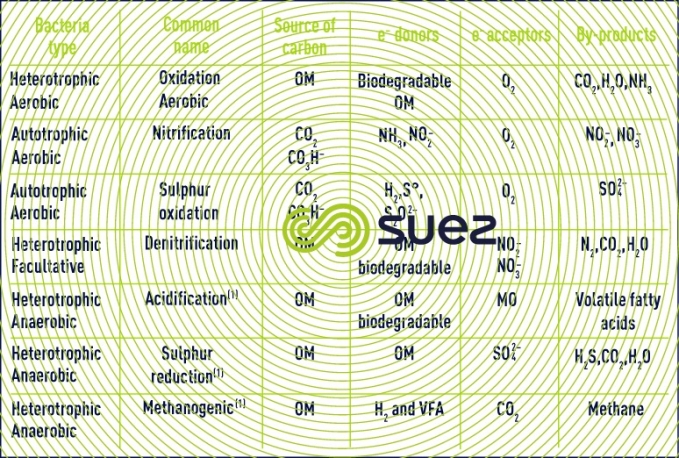aerobic cultures, anaerobic cultures
Reading time:Biological treatments used in water processing merely repeat natural phenomena. For heterotrophic bacteria, there are two ways of removing pollution from effluent:
- the aerobic digestion method. This is the method that occurs naturally in aerated water. The organic carbon in the substrate occurs as CO2 and biomass while organic nitrogen is present as NH4 (ammonification) or nitrate when the requisite conditions prevail (see page 2 of suspended growth (activated sludge));
- the anaerobic digestion method when reactions take place away from air, in a reducing medium. After it has been degraded, organic carbon can be found as CO2, and above all CH4, and as biomass. The weak oxidation reduction potential causes the nitrogen to become NH4, sulphur to become H2S or various types of organic sulphur compounds such as mercaptans.
The following equations follow the overall development of glucose via these two methods:


As the available energy is approximately 20 times higher using the aerobic method and as the synthesis of one gram of biomass requires the same amount of energy regardless of the method selected, the rate at which aerobic germs generate will be higher than that applicable to anaerobic germs and the carbon matter will break down far more rapidly. Conversely, less sludge will be produced with the anaerobiosis method.
The term anoxic is normally reserved for an environment that has no dissolved oxygen but that does contain nitrates. In this case, heterotrophic bacteria will obtain the oxygen they require from the nitrates, reducing these nitrates to N2 (the ‘denitrification’ reaction).
More generally, table 1 classifies bacterial cultures on the basis of their respective electron donors and acceptors, on the substrate available and on by-products found.



Bookmark tool
Click on the bookmark tool, highlight the last read paragraph to continue your reading later












